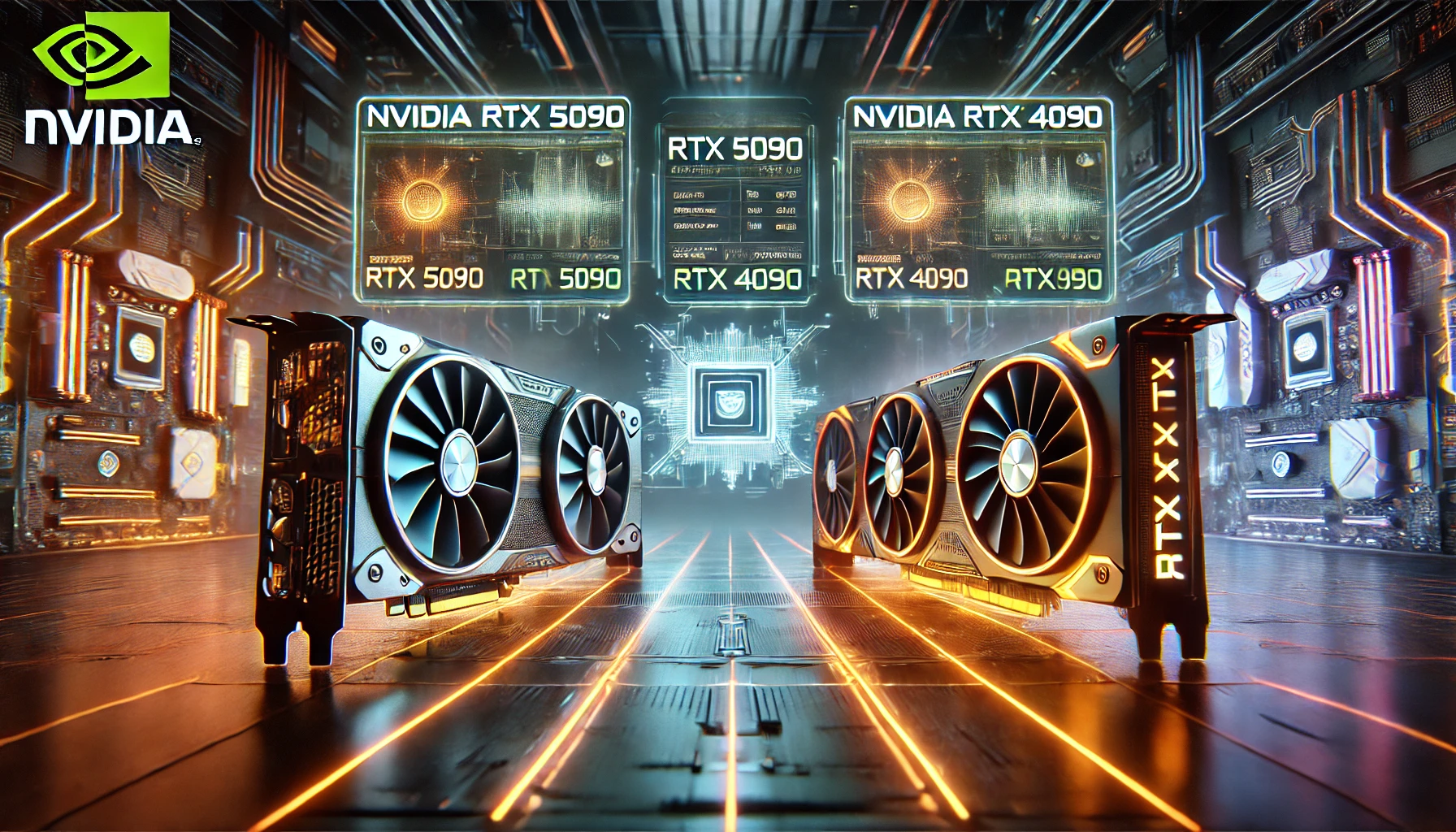RTX 5090 vs. RTX 4090: Unleashing the Next‑Gen GPU Revolution
When it comes to the cutting‑edge of both gaming and AI, NVIDIA’s newest flagship, the RTX 5090, stands shoulder‑to‑shoulder with the formidable RTX 4090. In this detailed comparison, we break down the core differences—from raw hardware specifications and pricing to real‑world gaming performance and creative workloads —and now also explore how these GPUs empower users to run local AI models efficiently.
1. Overview
NVIDIA RTX 5090
- Architecture: Built on the new Blackwell platform with 5th‑generation Tensor Cores, 4th‑generation RT Cores, and cutting‑edge GDDR7 memory.
- Target Audience: Designed for enthusiasts, gamers targeting ultra‑high resolutions (4K/8K), content creators, and professionals running local AI models.
- Design & Cooling: Slim, two‑slot Founders Edition with dual flow‑through cooling—ideal for high‑performance and small form factor builds.
- Launch Date: January 30, 2025
NVIDIA RTX 4090
- Architecture: Based on the Ada Lovelace generation with 4th‑generation Tensor Cores and 3rd‑generation RT Cores using GDDR6X memory.
- Target Audience: Still a top choice for 4K gaming and creative workloads, including local AI model tasks, though one generation behind.
- Launch Date: October 2022
2. Specifications Comparison
| Feature | NVIDIA RTX 5090 | NVIDIA RTX 4090 | Notes |
|---|---|---|---|
| Launch Date | January 30, 2025 | October 2022 | RTX 5090 is the latest flagship release |
| CUDA Cores | 21,760 | 16,384 | ≈33% more cores on the 5090 |
| RT Cores | 170 (4th Gen) | 128 (3rd Gen) | ≈33% increase |
| Tensor Cores | 680 (5th Gen) | 512 (4th Gen) | ≈33% increase |
| Boost Clock | ~2.41 GHz | ~2.52 GHz | RTX 5090’s clock is slightly lower (~4–5% less) |
| VRAM | 32 GB GDDR7 | 24 GB GDDR6X | ≈33% more capacity; newer, faster memory |
| Memory Bus Width | 512-bit | 384-bit | +33% wider bus |
| Memory Speed | ~28–30 Gbps | 21 Gbps | ≈33% faster effective speed |
| Memory Bandwidth | ~1,792 GB/s | ~1,008 GB/s | Up to 77% higher bandwidth |
| TDP | 575W | 450W | ≈28% higher power draw |
| MSRP (Launch Price) | ~$1,999 | ~$1,599 | RTX 5090 is positioned as a premium product |
3. Price / Performance Considerations
Pricing
- RTX 5090: Launched at an MSRP of approximately $1,999. Limited supply and high demand may push market prices higher. The best prices we found started at $2199 on Newegg for a Zotac card and $2400+ for a Gigabyte 5090 card.
- RTX 4090: Initially around $1,599, though retail prices have increased; discounted models may offer excellent value for 1440p gaming. We were able to source a new 4090 unit on eBay for around $900, although prices vary widely based on the exact card and model ranging anywhere from $900 to upwards of $3,000.
Performance Benchmarks
At 4K, the RTX 5090 delivers roughly 20–30% higher frame rates than the RTX 4090 (without DLSS 4 Multi Frame Generation). In many titles:
- 4K Gaming: Average FPS increases of about 26%, with minimum frame rates up to 29% higher in some cases.
- 1440p Gaming: Gains average around 18%.
- Creative & AI Workloads: Benchmarks in rendering and AI tasks show improvements from 12% up to 40%.
| Resolution | RTX 4090 (FPS) | RTX 5090 (FPS) | % Increase (Approx.) |
|---|---|---|---|
| 1440p | ~100 | ~118 | ~18% |
| 4K | ~60 | ~76 | ~26% |
4. Running Local AI Models
The increasing need to run local AI models—whether for real‑time inference, image synthesis, or accelerated training—has made GPU performance in AI workloads more crucial than ever. Both the RTX 5090 and RTX 4090 are popular choices, but here’s why the RTX 5090 takes the lead:
- Enhanced Tensor Compute: With 680 (5th Gen) Tensor Cores, the RTX 5090 delivers up to 1,676 TFLOPS of FP16 performance and substantially higher INT8 TOPS, reducing inference times and enabling faster local AI model execution.
- Increased Memory & Bandwidth: Its 32GB of GDDR7 memory on a 512‑bit bus provides nearly 77% higher bandwidth than the RTX 4090, allowing larger models and data sets to be processed locally with ease.
- Optimized AI Features: Advanced features like DLSS 4 and RTX Neural Shaders not only enhance gaming but also accelerate local AI tasks, making iterative development and experimentation more efficient.
- Practical Applications: Ideal for hobbyists and professionals running local AI workloads such as text generation, image synthesis, and real‑time inference—all benefiting from the RTX 5090’s robust architecture.
5. Additional Considerations
Memory & Future‑Proofing
The transition to GDDR7 memory in the RTX 5090 not only increases capacity (32GB vs. 24GB) but also boosts bandwidth significantly—crucial for 8K gaming and memory‑intensive AI tasks.
Power and Cooling
- RTX 5090: With a TDP of 575W, it requires a robust power supply (recommended ~1000W) but benefits from a redesigned cooling system that maintains temperatures around 70–72°C under load.
- RTX 4090: At 450W, it is less demanding power‑wise, which can be a factor in system design and cost.
Software & AI Enhancements
The RTX 5090 is the first GPU to leverage NVIDIA’s DLSS 4 with Multi Frame Generation—a technology that uses advanced transformer‑based models to predict and generate extra frames. This not only enhances gaming performance but also signals a new era of AI acceleration for local model inference and training.






Be the first to leave a comment